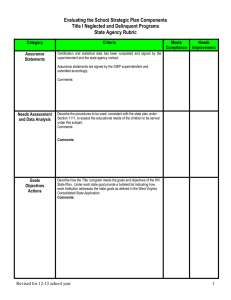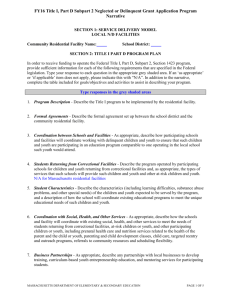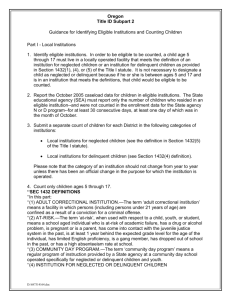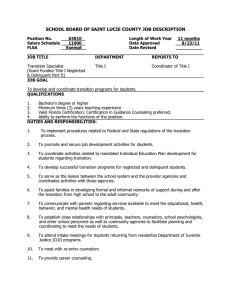TIPartD Subpart1 Narrative
advertisement
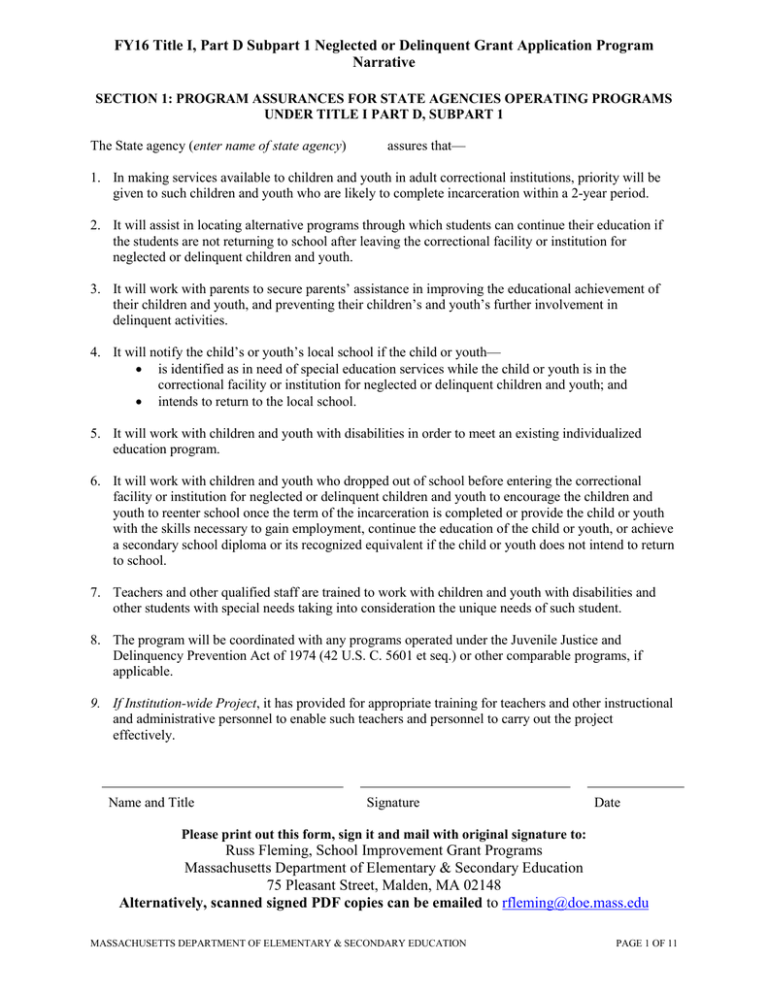
FY16 Title I, Part D Subpart 1 Neglected or Delinquent Grant Application Program Narrative SECTION 1: PROGRAM ASSURANCES FOR STATE AGENCIES OPERATING PROGRAMS UNDER TITLE I PART D, SUBPART 1 The State agency (enter name of state agency) assures that— 1. In making services available to children and youth in adult correctional institutions, priority will be given to such children and youth who are likely to complete incarceration within a 2-year period. 2. It will assist in locating alternative programs through which students can continue their education if the students are not returning to school after leaving the correctional facility or institution for neglected or delinquent children and youth. 3. It will work with parents to secure parents’ assistance in improving the educational achievement of their children and youth, and preventing their children’s and youth’s further involvement in delinquent activities. 4. It will notify the child’s or youth’s local school if the child or youth— is identified as in need of special education services while the child or youth is in the correctional facility or institution for neglected or delinquent children and youth; and intends to return to the local school. 5. It will work with children and youth with disabilities in order to meet an existing individualized education program. 6. It will work with children and youth who dropped out of school before entering the correctional facility or institution for neglected or delinquent children and youth to encourage the children and youth to reenter school once the term of the incarceration is completed or provide the child or youth with the skills necessary to gain employment, continue the education of the child or youth, or achieve a secondary school diploma or its recognized equivalent if the child or youth does not intend to return to school. 7. Teachers and other qualified staff are trained to work with children and youth with disabilities and other students with special needs taking into consideration the unique needs of such student. 8. The program will be coordinated with any programs operated under the Juvenile Justice and Delinquency Prevention Act of 1974 (42 U.S. C. 5601 et seq.) or other comparable programs, if applicable. 9. If Institution-wide Project, it has provided for appropriate training for teachers and other instructional and administrative personnel to enable such teachers and personnel to carry out the project effectively. Name and Title Signature Date Please print out this form, sign it and mail with original signature to: Russ Fleming, School Improvement Grant Programs Massachusetts Department of Elementary & Secondary Education 75 Pleasant Street, Malden, MA 02148 Alternatively, scanned signed PDF copies can be emailed to rfleming@doe.mass.edu MASSACHUSETTS DEPARTMENT OF ELEMENTARY & SECONDARY EDUCATION PAGE 1 OF 11 FY16 Title I, Part D Subpart 1 Neglected or Delinquent Grant Application Program Narrative SECTION 2: STATE AGENCY TITLE I, PART D PROGRAM PLAN In order to receive funding to operate the Federal Title I, Part D, Subpart 1 program, please provide sufficient information for each of the following requirements that are specified in the Federal legislation. Type your response to each section in the grey shaded area. In addition to providing a narrative description, you may complete the table included for goals/objectives and activities if it assists in describing your program. Type responses in the grey shaded areas 1. Student Eligibility and Assessment of Need Describe the procedures to be used, consistent with the State plan under section 1111 of the Title I legislation, to determine eligibility and assess the educational needs of the children to be served in your program. Describe: How documented youth served by this program meet the eligibility requirements described here: http://www.neglected-delinquent.org/nd/docs/nonregulatoryguidance_FINAL.doc; Uniform multiple criteria used for ensuring objective selection process (academic performance, tests, staff recommendations, school district records). If MCAS is used, indicate to what extent and how many students within the educational program are tested; Staff and auxiliary service providers who identified students most in need of support; and Methods and assessments used to document student progress throughout program year. 2. Program Description and Accompanying Budget Describe the program by specifying the services and activities that will be conducted and supported by Title I funds: Services and activities, including where they will take place; Instructional salaries; Supplies; As appropriate, activities and programs that involve parents, guardians, and family members; How services and activities are related to student outcome goals; and How services and activities will contribute to the successful transition of the student out of the facility. 3. Goals and Objectives Describe how the program will meet the goals and objectives of the State plan. Address, to the extent applicable, the following bulleted items. Alternatively, complete the attached FY2016 goals/objectives and activities form. Designate an individual in the facility or institution to be responsible for issues relating to the transition of children and youth from the facility or institution to locally operated programs; Student accrual of school credits that meet state educational secondary requirements; Student transition to LEA education program; MASSACHUSETTS DEPARTMENT OF ELEMENTARY & SECONDARY EDUCATION PAGE 2 OF 11 FY16 Title I, Part D Subpart 1 Neglected or Delinquent Grant Application Program Narrative Support systems, such as counseling, tutoring, learning centers, to ensure successful transition of students; Student transition for completion of education requirements to skills training program, higher education, or job entry; Support for students identified at risk of not completing public school program an and in danger of correctional facility assignment; High quality instruction, diverse transition opportunities, and dropout prevention services; and How program is consistent with the Massachusetts State Curriculum Frameworks student learning standards. 4. Consultation and Training for Institution-wide Projects Describe how the State agency will consult with experts and provide the necessary training for appropriate staff to ensure that the planning and operation of institution-wide projects under section 1416 are of high quality. Consultation and training should at least address the following bulleted items. Persons to be involved in planning; Sufficient planning time; Meeting intent and purposes of all programs/sources in entire educational program; Utilizing research-based effective practices appropriate to the population served; Continual review of student progress; and Continual revision of program, as necessary. 5. Evaluation Describe how the State agency will evaluate the effectiveness of its Title I, Part D program. 6. Coordination with Other Federal, State, and Local Programs Describe how the program will be coordinated with other appropriate State and Federal programs, such as programs under Title I of P.L. 105-220, vocational and technical education programs, State and local dropout prevention programs, and special education programs. Address the following bulleted items, along with any other information pertinent to your program, when completing this section. Frequency and extent of coordination; Service programs and outreach activities with public school districts; Community service agencies (health, counseling, employment, assessment and training); Municipalities; Institutions for higher learning; Services for students with disabilities; Services for students with limited English proficiency; Recidivism retention services; and MASSACHUSETTS DEPARTMENT OF ELEMENTARY & SECONDARY EDUCATION PAGE 3 OF 11 FY16 Title I, Part D Subpart 1 Neglected or Delinquent Grant Application Program Narrative If institution-wide project, how Title I funds are combined with other federal, state, and local funds to upgrade the entire educational program. 7. Coordination with School Districts or Alternative Education Programs for Shared Student Records Describe how the State agency will encourage correctional facilities receiving funds under Subpart 1 to coordinate with school districts or alternative education programs attended by incarcerated children and youth prior to their incarceration to ensure that student assessments and appropriate academic records are shared jointly between the correctional facility and the school district or alternative education program. 8. Professional Development Describe how appropriate professional development will be provided to teachers and other staff. Address the following bulleted items when completing this section. Professional development activities available for staff involved with Title I students (Note: All students are considered Title I students in institution-wide projects); Workshops, in-service, conferences, and college affiliations for staff; How activities will assist students in meeting the learning standards of the Massachusetts State Curriculum Frameworks; N or D institution-specific activities; and Activities implemented in coordination with other LEAs, MA DOE, public schools, and correctional facilities. 9. Coordination with Businesses for Training and Mentoring Describe how the State agency will endeavor to coordinate with businesses for training and mentoring for participating children and youth. Address the following bulleted items when completing this section. Efforts to coordinate; Actual coordination; Businesses involved in training and mentoring; and How such training and mentoring meets the student needs and goals of program. 10. Additional Services Describe any additional services to be provided to children and youth, such as career counseling, distance learning, and assistance in securing student loans and grants. MASSACHUSETTS DEPARTMENT OF ELEMENTARY & SECONDARY EDUCATION PAGE 4 OF 11 FY16 Title I, Part D Subpart 1 Neglected or Delinquent Grant Application Program Narrative SECTION 3: TITLE I PART D INSTITUTION-WIDE PROJECT PLAN A State agency that provides free public education for children and youth in an institution for neglected or delinquent children and youth (other than an adult correctional institution) or attending a communityday program for such children and youth may use Title I Part D, Subpart 1 funds to serve all children in, and upgrade the entire educational effort of, that institution or program. The institution-wide project plan must address in detail the first 7 requirements listed below. The assurance must be included in the signed assurance page that will accompany the agency’s plan. The plan and resulting outcomes must demonstrate that the intent and purposes of the programs for which funds are used collectively to upgrade the entire educational program are being met. Attach a comprehensive plan that is being submitted for approval by the SEA that— 1. Provides for a comprehensive assessment of the educational needs of all children and youth in the institution or program-serving juveniles. 2. Provides for a comprehensive assessment of the educational needs of youth aged 20 and younger in adult facilities who are expected to complete incarceration within a 2-year period. 3. Describes the steps the agency has taken, or will take, to provide all children and youth under age 21 with the opportunity to meet challenging State academic content standards and student academic achievement standards in order to improve the likelihood that the children and youth will complete secondary school, attain a secondary diploma or its recognized equivalent, or find employment after leaving the institution. 4. Describes the instructional program, pupil services, and procedures that will be used to meet the needs, including, to the extent feasible, the provision of mentors and youth. 5. Specifically describes how the subpart funds will be used. [Note that these funds may be used in combination with other funds used to implement the comprehensive plan for all children and youth being served.] 6. Describes the measures and procedures that will be used to assess student progress. 7. Describes how the agency has planned and will implement and evaluate the institution-wide or program-wide project in consultation with personnel providing direct instructional services and support services in institutions or community-day programs for neglected or delinquent children and youth and with personnel from the SEA. 8. Assurance [Note: The required assurance related to institution-wide projects is included as #9 in the assurance section at the beginning of this application package.] MASSACHUSETTS DEPARTMENT OF ELEMENTARY & SECONDARY EDUCATION PAGE 5 OF 11 FY16 Title I, Part D Subpart 1 Neglected or Delinquent Grant Application Program Narrative SECTION 4: TRANSITION SERVICES Type responses in the grey shaded areas Each State agency shall reserve funds (see Fiscal Information page of this application package for calculating reservation) each fiscal year to support transition services. Provide a plan that describes— Projects that facilitate the transition of children and youth from State-operated institutions to schools served by school districts; or The successful reentry of youth offenders who are age 20 or younger and have received a secondary school diploma or its recognized equivalent into postsecondary education or vocational and technical training programs, through strategies designed to expose the youth to, and prepare the youth for, postsecondary education or vocational and technical training programs such as— o o o Pre-placement programs that allow adjudicated or incarcerated youth to audit or attend courses on college, university, or community college campuses, or through programs provided in institutional settings; Worksite schools in which institutions of higher education and private or public employers partner to create programs to help students make a successful transition to postsecondary education and employment; and Essential support services to ensure the success of the youth, such as— personal, vocational and technical, and academic counseling; placement services designed to place the youth in a university, college, or community college setting; information concerning and assistance in obtaining available student financial aid; counseling services; and job placement services. Contracted Services Transition services projects may be conducted directly by the State agency or through a contract or other arrangement with one or more school districts, other public agencies, or private nonprofit organizations. If your agency has entered in a contract or other arrangement, please attach the contract to your application. MASSACHUSETTS DEPARTMENT OF ELEMENTARY & SECONDARY EDUCATION PAGE 6 OF 11 FY16 Title I, Part D Subpart 1 Neglected or Delinquent Grant Application Program Narrative SECTION 5: FISCAL INFORMATION Transition Services Each State agency shall reserve not less than 15% and not more than 30% of Subpart 1 funds for any fiscal year to support transition services for children and youth. Subpart 1 funds: $ x .15 = $ Minimum Subpart 1 funds: $ x .30 = $ Maximum Subpart 1 funds reserved: $ MASSACHUSETTS DEPARTMENT OF ELEMENTARY & SECONDARY EDUCATION PAGE 7 OF 11 FY16 Title I, Part D Subpart 1 Neglected or Delinquent Grant Application Program Narrative SECTION 6: TITLE I NEGLECTED OR DELINQUENT STUDENTS IN STATE CORRECTIONAL AND YOUTH FACILITIES FUNDING APPLICATION ENROLLMENT – FY2016 NOTE: Please provide the following information for each site that is a recipient of Title Neglected or Delinquent Funds (check one for each category). Indicate Type of Facility: State Youth Facility State Correctional Facility Identify students serviced – must remain as originally assigned on fall survey: Neglected Name of Facility: Address: City/Zip: Contact Person-Education Program: Telephone # (if different from above): A. Delinquent Telephone #: Position/Title: Email address: PROJECTED ENROLLMENT FOR FY2016 This project will provide Title I services for approximately students within the following Instructional service areas. (Indicate the projected number of students expected to be enrolled in the service area using the appropriate column). SERVICE AREA NEGLECTED DELINQUENT ADULT CORRECTIONAL TOTAL INSTRUCTIONAL: Reading Other Language Arts (not above) Mathematics Other (specify): SUPPORTING: Guidance/Social Work Health/Nutrition Pupil Transportation Other (specify): MASSACHUSETTS DEPARTMENT OF ELEMENTARY & SECONDARY EDUCATION PAGE 8 OF 11 FY16 Title I, Part D Subpart 1 Neglected or Delinquent Grant Application Program Narrative B. INSTRUCTIONAL DATA NOTE: State youth residential facilities must provide a minimum of 20 non-Title I instructional hours/week to students. State Correction facilities must provide a minimum of 15 non-Title I instructional hours/week to students. B-1 STUDENT INSTRUCTIONAL HOURS Hours/Week Title I Non-Title I Total hours B-2 INSTRUCTIONAL TERM COVERED BY THIS APPLICATION (check one) Regular School Year Only Summer Program Only School Year and Summer Program MASSACHUSETTS DEPARTMENT OF ELEMENTARY & SECONDARY EDUCATION PAGE 9 OF 11 FY16 Title I, Part D Subpart 1 Neglected or Delinquent Grant Application Program Narrative SECTION 7: GOALS/OBJECTIVES and ACTIVITIES (Required) Instructions: Using Title I, Part D data evaluation that is collected from you annually (referred to by USED and ESE as the CSPR: Consolidated State Performance Report) and other data available, estimate targets on the indicators listed in Section I. Then, list actions that will help achieve those targets. Try to estimate targets that are achievable, however modest, and that can be tracked during the course of the year. Note the tracking tool or instrument used in the last column. The information in Section II is intended to help the Department understand and record additional indicators, if any, facilities are using to measure and record success and/or challenges. Examples have been provided for this section eliciting non-CSPR related indicators (blue font section), such as attendance, courses offered, and quality of educational environment; Example 1 has all the columns filled in. In this section, percentages may not be applicable, instead, use a count or other measure. FY 2016 Selected CSPR and Additional Indicators with Targets Section I Selected CSPR Indicators* SY 2013-14 CSPR data or more recent data** SY 2015-2016 Targets SY 2014-2015 data, if available Targets SY 2015-2016 Actions to Help Achieve Target(s) Tool/Instrument to Track Target(s) Actions to Help Achieve Target(s) Additional outreach will be provided by staff to encourage individuals to participate Tool/Instrument to Track Target(s) Attendance sheets used daily to track participants Earned high school course credits Earned a high school diploma or GED/HISET Improved in reading on pretests and posttests Improved in mathematics on pretests and posttests Additional Indicators Section II Example 1: Students participating in Title I classes as a percentage of individuals counted in the annual count Other Examples: attendance of enrolled students; number of classes students taking; number of courses being offered in facility for participating students; enhancement of educational setting, such as an increase in educational classroom space or library offerings. Of 150 individuals counted, only 50 chose to participate in classes Target in SY1516 is to have 75 students participate regularly * Note: In this section use percentages, for example, 10% of students earned a high school diploma this year and the target is 15% for 2015-16. ** This data was provided to the Department in the SY 2014-15 data evaluation collection (CSPR). MASSACHUSETTS DEPARTMENT OF ELEMENTARY & SECONDARY EDUCATION PAGE 10 OF 11 FY16 Title I, Part D Subpart 1 Neglected or Delinquent Grant Application Program Narrative SECTION 8: DEFINITIONS ADULT CORRECTIONAL INSTITUTION: A facility in which persons (including persons under 21 years of age) are confined as a result of a conviction for a criminal offense. AT-RISK: When used with respect to a child, youth, or student, means a school aged individual who is at-risk of academic failure, has a drug or alcohol problem, is pregnant or is a parent, has come into contact with the juvenile justice system in the past, is at least 1 year behind the expected grade level for the age of the individual, has limited English proficiency, is a gang member, has dropped out of school in the past, or has a high absenteeism rate at school. COMMUNITY DAY PROGRAM: A regular program of instruction provided by a State agency at a community day school operated specifically for neglected or delinquent children and youth. INSTITUTION FOR NEGLECTED OR DELINQUENT CHILDREN AND YOUTH: A. A public or private residential facility, other than a foster home, that is operated for the care of children who have been committed to the institution or voluntarily placed in the institution under applicable State law, due to abandonment, neglect, or death of their parents or guardians; or B. A public or private residential facility for the care of children who have been adjudicated to be delinquent or in need of supervision. MASSACHUSETTS DEPARTMENT OF ELEMENTARY & SECONDARY EDUCATION PAGE 11 OF 11
